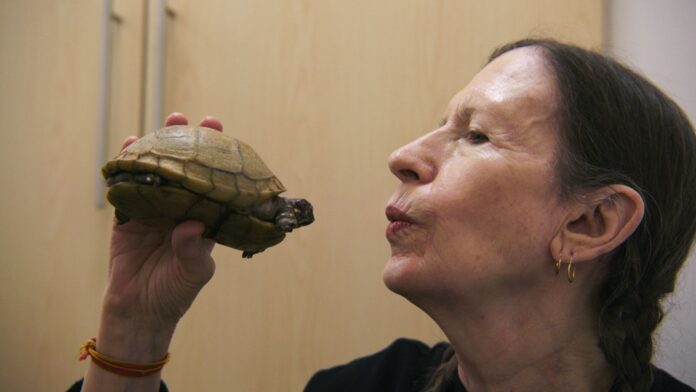Screen Grabs is our weekly peek at what’s coming to cinemas, art houses, and personal viewing devices within your vicinity—with occasional reappraisals of the classics.
The artistic life is explored in several new documentaries opening this week, each focusing on a singular talent that has acquired fervent followings of almost cult-like worship over the decades. One subject is still with us: Meredith Monk. As Billy Shebar’s film Monk In Pieces: A Concept Album emphasizes, her interdisciplinary art is so original, it has largely flown under the popular radar simply because no one knows how to categorize it.
Now in her early eighties, she was started on her path in childhood by developing strabismus (i.e. “lazy eye”), whose related disabilities were dealt with by enrollment in a Dalcroze eurhythmics course. Its twinning of music and movement was amplified throughout her career, first in NYC’s 1960s experimental dance world, then in ’70s underground performance-art spectacles, then in film, opera, and other media. Long ago she began being most identified with composing vocal music, often wordless and unaccompanied, for soloists or ensembles. All these disciplines are approached with a minimalist rigor that can seem simple, even childish at first exposure. But they will grow on you. In combination, they can—and almost always do—achieve remarkable complexity and resonance.
So, what is she? An avant-garde composer? A choreographer? A theatrical innovator a la the just-deceased Robert Wilson? While we theoretically prize individuality, the difficulty in placing someone like Monk—who does all the above, with little obvious indebtedness to any prior models—underlines just how dependent on labeling we are in rewarding high achievers. Monk in Pieces ends with her accepting a National Medal of Arts from President Obama a decade ago, though she was surely the most puzzling recipient for most. (Others getting the nod that year included Sally Field and Stephen King.) There’s a wealth of archival performance footage throughout, but how easily accessible are their longer versions to the general public?
A running theme in the documentary is the eternal struggle to secure funding for work so far out of the mainstream. Less convincingly, Shebar makes a recurrent motif of her getting bad reviews from narrow-minded churls—those sniffy notices read aloud by actors doing the stereotypical “hoity know-it-all” voice of snobs and society matrons who get pies thrown at them in Three Stooges comedies. But as someone who’s been following Monk since 1981 (when her first album Dolmen Music was released), I can’t recall anything but press adulation directed her way.
Well, that’s not strictly true: When in the early 1990s there was a minuscule theatrical release of her only feature film, the ravishing historical abstraction Book of Days, a dunderheaded slam in the SF Chronicle made its Castro Theater run a box-office disaster. Pieces, which is organized in biographically non-chronological sections, also suggests that the 1991 world premiere production of her sole opera to date (Atlas at Houston Grand Opera), was dogged by institutional doubts about her unconventional vision and process—though in the end it was very well-received. Some of these elements feel like an attempt at generating narrative conflict where in reality there isn’t much to be found. Certainly Monk herself (whom I’ve met) has always seemed like a uniquely warm, generous personality and collaborator.
This isn’t the first documentary about her. But it is the best, with the virtue of being able to provide an overview of a six-decade career she acknowledges she’s probably near the end of. Limited insights into her personal life include musings on the problematic relationship with her singer mother, apparent coupledom for a while with 1971-83 creative partner Ping Chong, and long-term domestic partnership with company member Mieke Van Hoek, who passed away at age 56 in 2002. She is lauded as an inspiration by the present-day likes of Björk and David Byrne, archivally by Merce Cunningham and Philip Glass, the latter saying of the fertile 1970s Manhattan avant-garde scene, “she among all of us was I think the uniquely gifted one.” There are animation sequences illustrating dreams she’s noted in her journals.
While it’s almost impossible to describe a fully realized multimedia Monk work to someone who’s never seen one, the various performances glimpsed here are more inviting than baffling—they look (and sound) fascinating, as well they should. Then there’s Monk herself, an ingratiatingly modest and open character who seems to have no resentments or dirt to dish. A concern in Pieces is: What happens to all his unpinnable art when she passes away? Does it simply vanish? I worry about that, too—and whether I’ll ever get to see Atlas, which has been released as an audio recording but not a full video one, and has never been mounted in California. Monk in Pieces, which opens this Fri/8 at SF’s Roxie and at the Smith Rafael Film Center in Marin, offers manna for fans, and might well make converts out of the merely curious.
Hardly lacking for camp followers are the two male subjects for other new bio-docs, both of whom had premature deaths sanctify the romance of their cult status. Amy Berg’s It’s Never Over, Jeff Buckley pays probably definitive homage to the shortlived singer-songwriter who completed just one album, Grace, before he drowned at age 30, in 1997. He was famously the son of 1960s folkie Tim Buckley, another figure whose legend grew after he died young—but while junior’s voice invariably recalled “dad,” the elder Buckley had almost no part in his upbringing. Instead, he was raised alone by mother Mary Guibert, who conceived him while still in high school, and, as she says, “knew from the fifth month [of pregnancy] that I was never going to see Tim again.”
That paternal gap was just one of many giant chips that apparently settled on the boy’s shoulders. His mom admits “certainly I was a flawed parent” (though this movie is fuzzy on details), and late in life Jeff reportedly diagnosed himself as manic depressive. A 2012 drama that portrayed both father and son in different time periods, Greetings From Tim Buckley, depicted Jeff as an exasperating, sulky manchild. But there was no doubt he was gifted—in bands from early teen years, absorbing influences as disparate as Led Zep, jazz fusion guitarist Al Di Meola, Nina Simone, qawwali singer Nursat Fateh Ali Khan, Edith Piaf and Siouxsie Sioux.
After making a splash in NYC (initially at a posthumous tribute to his father he was reluctant to participate in), he signed with Columbia and made Grace—a sonic anomaly during the grunge era that was not a commercial success at first, though now it’s widely considered a classic. Nonetheless, fame, record-label debt and pressure to do better weighed very heavily on him. The film suggests he was getting his act together (and recording again) after a rough patch when a spontaneous swim in dangerous waters claimed his life.
I like Grace—and his transcendent cover of Leonard Cohen’s “Hallelujah”—as much as anyone. Still, this very well-crafted overview might almost be too much tribute for a very short career, at nearly two hours’ length. We hear from his mother, ex-girlfriends Rebecca Moore and Joan Wasser, collaborating musicians, admirers like Ben Harper, and so forth. Inevitably, a certain tragic hindsight sentimentality begins to obscure the real-world person, with much more focus on Buckley’s demise than the entire first two-thirds or so of his life.
Still, he does fascinate as a figure whose scant surviving work was singularly accomplished—and with so many creative impulses warring within him, who knows what he might have achieved later on? It’s Never Over opens Fri/8 at SF’s Roxie Theater (more info here). Also showing immediately after the feature is a newly remastered, hitherto unreleased 26-minute Buckley solo performance film shot in early 1994.
Unavailable for preview (if only because I experienced some technical hiccups) was Ebs Burnough’s Kerouac’s Road: The Beat of a Nation, about the lasting impact of On the Road—still the boho Bible for those seeking literary permission to roam in life, almost seventy years after publication. It was followed by so much…but who reads Hesse now? Or Castaneda? Or Zen and the Art of Motorcycle Maintenance? Yet somehow the allure of the Beats and its most famous author lingers, generation after generation.
I have mixed feelings about that… despite once having lived around the corner from the SF house where Jack, Neal, and Carolyn cohabited for a while before they all became legends. Kerouac himself had a very conflicted relationship to fame and On the Road, which has doubtless remained his most popular book by far precisely because it was the only one that was heavily edited. The stream-of-consciousness style that flowed freely in his less-compromised tomes is, to me, more interesting for the liberating effect it had on popular writing in general than for any lasting artistic value.
But hey, opinions differ. Kerouac’s Road is an ode to that book’s long-term influence, purportedly with room for criticism (Natalie Merchant discusses the Beat Generation’s embedded misogyny), but heavier on the thankful accolades from such latterday celebrities as actors Matt Dillon, Josh Brolin and Michael Imperioli; writers W. Kamau Bell and Jay McInerney; plus some less-starry people who remain committed to “the road” as a lifestyle as a result of their formative reading crush. The documentary opens at Berkeley’s Elmwood and Marin’s Rafael Film Center on Fri/8.
Finally, death is anything but romanticizing in Life After, which is not a portrait of an artistic figure but of those who put themselves forward as spokespersons for the right-to-die movement. In 1983 Riverside, CA, 26-year-old Elizabeth Bouvia admitted herself to a psychiatric hospital in order to be “left alone” and to “starve myself to death.” She was almost wholly paralyzed by cerebral palsy, in near-constant pain, and “tired of being dependent on others for everything.” All she wanted was an opportunity to stop being a “burden to society” and check out from this mortal plane on her own terms.
But hospital staff refused to cooperate. She wound up taking her case to court with an ACLU lawyer, attracting national media attention. But the judge ultimately ruled against her wishes, too. After more losses (during which she was tortuously force-fed), she gave up the fight and lived on quietly—for decades. So quietly that Bay Area filmmaker Reid Davenport (I Didn’t See You There) was well into this project before he finally learned that she had passed away a decade earlier.
His engrossing film doesn’t concern itself solely with Bouvia’s story. There are other cases spotlit, including a Canadian man who wanted to end his life after the demise of his primary-caregiver mother made continuing almost logistically impossible. (As is pointed out, that nation’s “universal healthcare” comes with some sharp limitations, and long waitlists.) A 14-year-old in Wisconsin felt likewise after enduring 30+ surgeries, even though her condition wasn’t considered “terminal.” On the other hand, a woman whose husband became quadriplegic after cardiac arrest in 2017 argues that he was “murdered” by a relative’s decision to pull the plug.
Though it initially seems headed towards a straighforward plea for euthanasia rights, Life After grows knottier and knottier. Should the afflicted party always be allowed the option of assisted suicide? What if they are immature, or unduly influenced by pain that might ease over time? If they are not in a position to make that determination themselves, who does have the right? How do we determine abstractions like measuring “quality of life”? Some disability advocates fear the rush to “relieve suffering” via laws like Canada’s MAiD (Medical Assistance in Dying) is really a new form of eugenics, providing society another way to simply rid itself of high-cost care and “unwanted” people.
It’s a very complicated and clashing array of arguments that this provocative documentary doesn’t hope to resolve—it just offers weighty food for thought. Life After plays this Sun/10 at SF’s Roxie with Davenport present for a moderated post-screening discussion; for those who can’t make it in person, there will also be virtual (i.e. streaming) showings at 7 pm Tues/12 and Wed/13. More info here.





